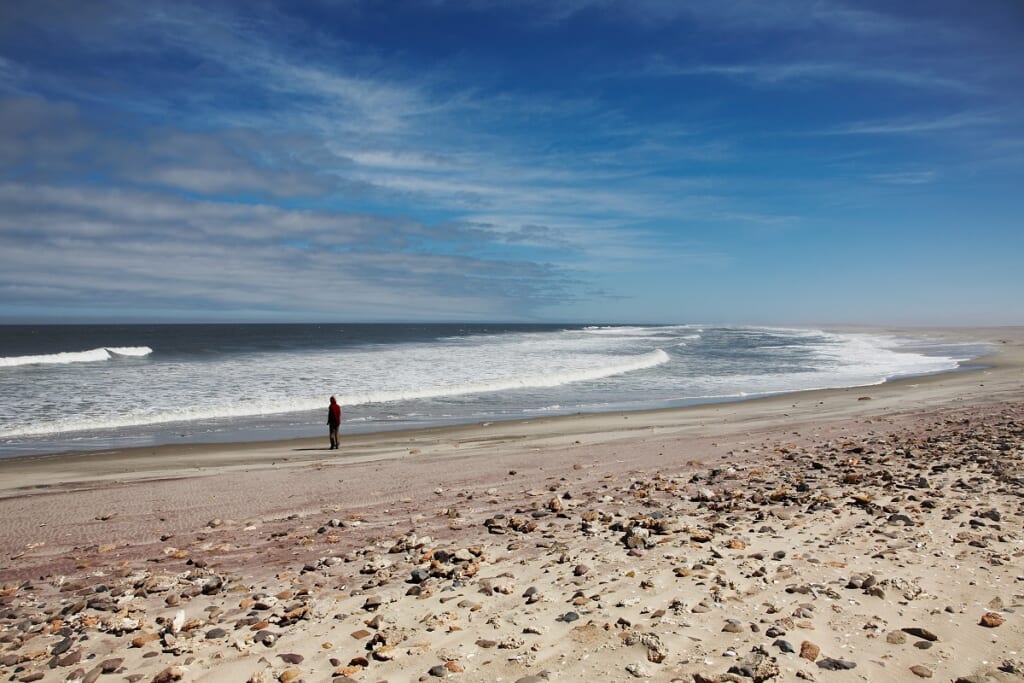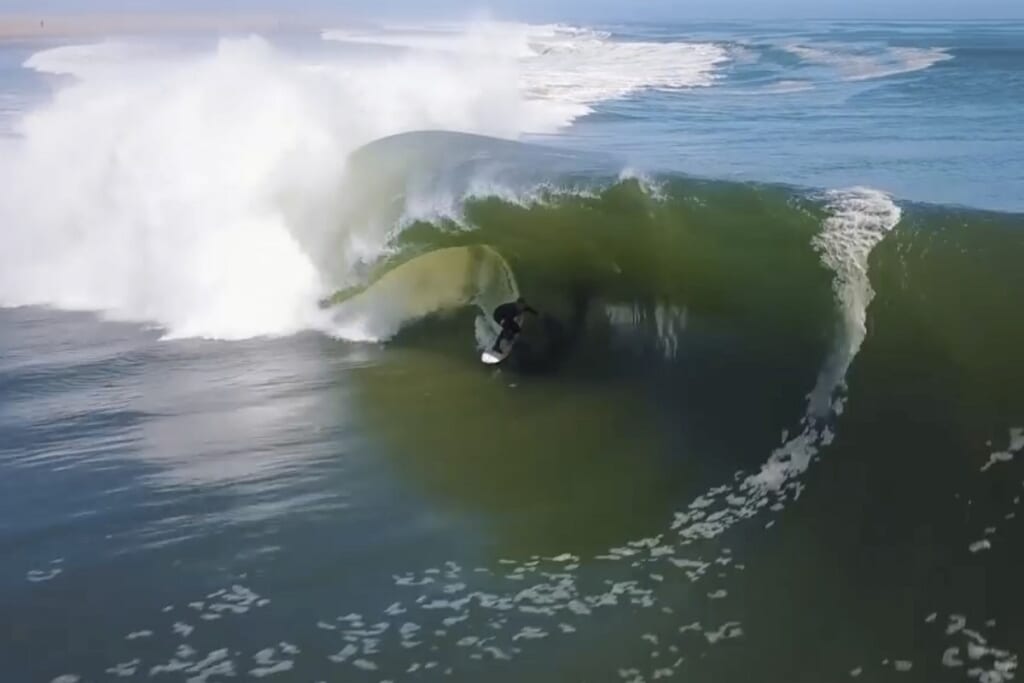コア・スミスはその瞬間、完璧な場所にいた、というのが的を射ている。
彼は単純に運が良かった、というのは的外れだ。
サーフボードの上で危なげにたたずんでいたハワイ出身で23歳のコア・スミスは、アフリカ西海岸のナミビア沿岸で2分間も波に乗り続けた。彼は約1.5kmもの距離を倒れることなく進み、8つのバレルに入る、という前人未踏のチューブライディングを成功させた。バレルとは、頭上を越えるカーブを描いてトンネル状になった波のことだ。
信じられないことに、スミスとカメラマンのクリス・ロジャースは頭上に飛ばしたドローンと、スミスがマウスピースに装着したGoProカメラを使い、一連の様子を撮影していた。
先月成し遂げた、過去に類を見ない波上での偉業について、スミスは「これまでの人生でやってきたことすべてが、あの瞬間のためにあったと思います」と話した。
スミスは自身の成功について、「どんな時も計算高い科学者、そして向こう見ずでリスクを恐れない冒険者でいたこと」の結果だと考えている。
気象学者が、嵐が来る数日前からそれを追跡するのと同じように、スミスをはじめ、世界クラスのサーファーの多くは、天気図を見て最大級の波がいつどこにやってくるかを予想する技術を習得している。いつ来るかを予想することと、実際にその場所に行くことはまた別の話なのだが、スミスは完璧な波に出会うためには、自分のすべてを賭けることもいとわない。
スミスの広報担当者、ライアン・ランケは「彼は日ごとに、居る場所が変わります。電話をすると、『明日アフリカに行くから』と言うんです」と話す。
彼が最大の偉業を成し遂げたのは、スケルトン・ベイという、南大西洋に面したアフリカ西海岸の神秘的な海岸線だ。

Dmitry Pichugin / Shutterstock.com
現地に詳しい知り合いがいない限り、そこに行こうとはしないほうがいい。スケルトン・ベイに行くには、まずハワイから飛行機で2日間移動し、それから砂漠の中を車で走ることになる。砂だらけで標識もない道を旅しなければ、海にはたどり着かない。最終的に一面に広がるビーチにたどり着くが、そこは数百もの攻撃的なアザラシの群生地であり、何千というジャッカルも生息しているため、なんとか現地に到着した幸運な一握りのサーファーは、彼らと空間を共有することになる。ひとたび海に入れば、巨大な白いサメに出会うこともある。
「現地に行けば、本当にそこに身をおくわけで、ある意味自分しかいないということです」とスミスは言う。「ただ実際にその場では、そんなことは考えません。自分の生活を犠牲にして、そこにいることが分かっているので」
スミスはカウアイ島で育ち、ハワイの多くの子供たちと同じ道のりを経て、サーフィンを始めたという。
「カウアイ島では、他にやることがあまりないんです」と彼は言う。「両親にビーチに連れて行ってもらって、砂で遊び、海で遊び、ボディサーフィンやブギーボードをして、と段階を追っていくわけです。サーフィンを始めたのは3歳の時です。4歳年上の兄がいるのですが、兄がサーフィンを始めた時に思ったのです。兄にできることなら、自分にもできるだろうと」
スミスは6歳のとき10歳以下のアメリカ代表メンバーに選ばれ、12歳の時に初めてナイキと契約を結んだ。
サーフィンは、同じアクションスポーツで遠い親戚のような、スノーボードよりもはるかに長い歴史がある。しかし、今、海洋スポーツのアスリートは、20年前にスノーボーダーが出会ったのと同じ問題と向き合っている。
2020年の東京オリンピックからサーフィンは正式種目となる。しかし、ただ波と映像を楽しむ、ライフスタイルスポーツのままにしておきたい人と、競技という側面により収益性を見出す人に分かれている。サーフィンの場合、後者はすでに確立された歴史がある。
すぐにオリンピックを目標にするわけではないものの、スミスは数多くのコンテストに出場している。「競技として参加するからには、状態の悪い波でもうまく乗らなければなりません」と彼は言い、それらを排除してはいない。
「パフォーマンスのプレッシャーを感じると、深く掘り下げることができ、別の方法では感じることのできない何かを、感じることができます」と彼は言う。
しかし、ある意味では、彼は金メダルを獲得したのだ。あの日、スケルトン・ベイで起きたことは、彼の記憶と動画の中で、非常に長い間生き続けることになるだろう。

Chris Rogers via AP
彼は伝説のチューブライディングについて、このように語っている。
「4つ目のバレルで、これはすごい、と思った瞬間がありました。これで波は終わりか、と思ったのですが、また形ができてきました。私は、ドローンはそこにあるし、自分もこのまま行けるかもしれないと思いました。そして、『よし!これはただの良い波ではなく、人生を変える波になった』と感じたのです」
By EDDIE PELLS, AP National Writer
Translated by isshi via Conyac
To say Koa Smith was at the right place at the right time is perfectly accurate.
To say he got lucky — that’s missing the point.
Perched precariously on his surfboard, the 23-year-old from Hawaii rode a wave off the coast of Namibia, on the western shore of Africa, for 120 straight seconds. He stayed upright for nearly a mile (1.5 kilometers) as he traveled through an unheard-of eight barrels — the hollow formed by the curve of the wave as it breaks over the rider’s head.
Almost as amazing — Smith and videographer Chris Rogers filmed the entire ride using both a drone that hovered overhead, and a GoPro attached to a mouthpiece that Smith wore while he rode.
“I’d like to think that everything I’ve done my whole life led up to that moment,” Smith said of his masterpiece over a one-of-a-kind wave last month, the likes of which has never been documented before.
Smith owes his success to being every bit as much a calculated scientist as a devil-may-care risktaker.
Much as a meteorologist tracks storms several days before they hit, Smith and many world-class surfers have mastered the art of reading weather charts to predict when and where the greatest sized ocean swells will hit. It’s one thing to know they’re coming, quite another to get to where the action is, and Smith is more than willing to drop everything in search of the perfect wave.
“He can be in one place one day, and you call him and he says, ‘I’m taking off for Africa tomorrow,'” says Smith’s publicist, Ryan Runke.
The locale of his greatest triumph is called Skeleton Bay — a mystic stretch of beach fronting the South Atlantic on the western coast of Africa.
Don’t bother trying to go unless you know someone who knows the area. It’s a two-day plane ride from Hawaii, followed by a car ride through the desert, culminating with a journey down a stretch of sandy, unmarked roads that lead to the ocean. The final stop is at a stretch of beach where a lucky handful of surfers share space with hundreds of aggressive seal colonies, thousands of jackals and, once in the water, the occasional great white shark.
“When you’re out there, you’re really out there, and you’re kind of on your own,” Smith said. “But when you’re out there, you’re not thinking about it. You know you’re sacrificing your life for this.”
Smith grew up on Kauai and said he got into surfing the way many Hawaii kids do.
“There’s not much to do there,” he said. “My parents would drop us off at the beach. You start playing in the sand, playing in the ocean, body surfing, boogie boarding and it keeps evolving. I started surfing when I was 3. My brother is four years older. When he started, it was, ‘If he can do this, I can do this.'”
Smith qualified for 10-and-under nationals when he was 6; he had his first Nike contract by age 12.
Though surfing has been around much longer than its distant action-sports cousin of snowboarding, athletes in the ocean sport are now faced with some of the same questions the snowboarders dealt with 20 years ago.
Surfing is making its debut at the Olympics in 2020 and there figures to be a divide between those who want to keep it as a lifestyle sport — chasing waves and footage — and those who see a more lucrative path on a competitive side, which, in surfing’s case, already has a well-established history.
Though the Olympics are not his immediate goal, Smith does surf in plenty of contests — “If you compete, you have to be really good at riding bad waves,” he says — and has not ruled them out.
“There’s something about performance pressure that allows you to dig deep and feel something you couldn’t real feel any other way,” he said.
In a way, though, he’s won his gold medal. That day on Skeleton Bay will live on, both in his mind and on the video, for a very long time.
“There was a point where I was at four barrels and I was already like, ‘This is amazing,'” he said. “It looked like the wave was over, but it formed again. I figured, the drone’s there, I might as well stay on. And I was like, ‘Whoa!’ This went from a good wave to like a life-changing wave.”



